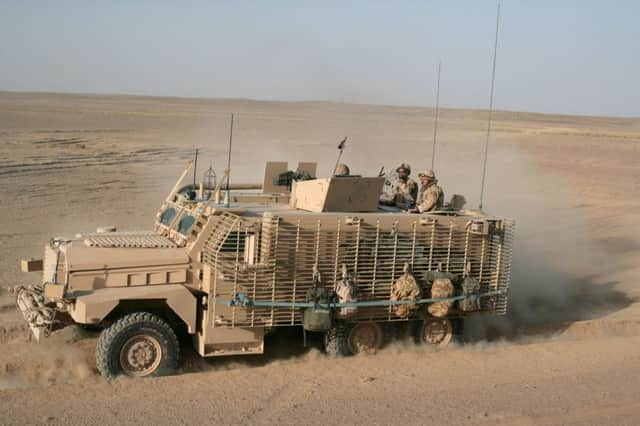Scots soldiers died in ‘death trap’ armoured car


Coroner Darren Salter said he would file a report with the Ministry of Defence outlining how be believes further blast deaths could be avoided, after the trio were killed on patrol in Afghanistan.
Corporal William Savage, 30, Fusilier Sam Flint, 21, and Private Robert Hetherington, 25, suffered devastating blast and spinal injuries when their vehicle was struck by the huge bomb on 30 April last year.
Advertisement
Hide AdAdvertisement
Hide AdAn inquest heard how a top-secret bomb detection system had picked up numerous signs of insurgent activity in the days before the blast, but that these reports had not been passed on to patrols after being put down to a machine error.
The coroner yesterday ruled the trio were unlawfully killed while on active service. Mr Salter said: “Whilst it is always easy to deal with things with the significant benefit of hindsight, it does seem the nature of the ‘hits’ and period over which they were received should have been more widely circulated, which would have allowed an opportunity to consider more informed actions including a high-risk search.
“The opportunity to consider further actions was therefore missed.”
CONNECT WITH THE SCOTSMAN
• Subscribe to our daily newsletter (requires registration) and get the latest news, sport and business headlines delivered to your inbox every morning
Confirming he would write to Mr Fallon, the coroner added: “The issue I am focused on is the reporting of threats and intelligence of threats, and the way these threats are then cleared.”
He also ruled defects on the Mastiff 2 armoured truck the trio were travelling in, caused by a 2009 improvised explosive device (IED) blast, may have made them more vulnerable to attack.
He said: “There was outward flaring at the bottom of the doors, probably by approximately one inch, due to the IED strike in 2009. This could make it easier for a blast to then remove the doors. With the history of the Mastiff in countless IED strikes, there isn’t any evidence that it did not provide the necessary level of protection, but the occupants were more vulnerable to the blast because of the damage from the 2009 IED blast.”
The armoured truck had been deemed “non-taskworthy” just months before the explosion, but was then reclassified as operational a week later, despite there being no obvious evidence of repairs having been done.
Advertisement
Hide AdAdvertisement
Hide AdExpert Stuart Cowling, who specialises in armoured vehicle design, told the hearing yesterday that if the 2009 damage had not been repaired properly, the vehicle would have “lacked the structural integrity” of a model fresh from the factory.
He said he disagreed with the assessment of army mechanics at the time who described the damage, to the skirting and hinges surrounding the doors, as “purely cosmetic”. “Strictly speaking, any unrepaired damage to the locks or skirt will have contributed to the removal of the doors during the 2013 IED attack. A split weld would inevitably lead to a weakness and should be repaired.”
The inquest was told the trio had reported the doors were not closing properly and were “flared out” at the bottom, leaving a gap about an inch wide, just weeks before their deaths. On one occasion, the deadlocks on the armour-plated doors had malfunctioned and they could not be opened for 45 minutes.
Yesterday, the inquest was shown a handwritten investigation report, dated 7 November 2012, which showed that the Mastiff’s electronic counter measures system, which is designed to jam remote IEDs, was judged “non-taskworthy”.
Also included on the page was a handwritten note which said “repair rear doors”.
However, shortly afterwards, another engineer went through the report card and crossed out all of the comments, replacing them with “taskworthy”.
The men were sitting at the back of the vehicle when it was blown up, flipping it on to its side, blasting the rear doors off and removing the front wheels.
Cpl Savage, from Penicuik, Midlothian, and Fus. Flint, from Edinburgh, were both from the 2nd Battalion the Royal Regiment of Scotland, while Pte Hetherington, also from Edinburgh, was part of 7th Battalion the Royal Regiment of Scotland.
Advertisement
Hide AdAdvertisement
Hide AdAll three were based in Forward Operating Base Ouellette in the northern area of Nahr-e Saraj district, Helmand province.
SCOTSMAN TABLET AND IPHONE APPS